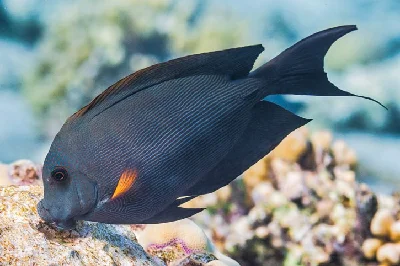Acanthuridae
Surgeonfishes, also known as tangs, are a fascinating group of marine fishes found in tropical and subtropical waters around the world. They are known for their distinctively colorful bodies, sharp spines on their tails, and a scalpel-like spine, or "scalpel," on either side of their caudal peduncle - the narrow part of the body just before the tail.
These fish belong to the family Acanthuridae and are further classified into multiple genera and species, each with its own unique characteristics. Surgeonfishes are usually medium-sized, ranging from 15 to 38 cm (6 to 15 inches) in length, although some can grow larger. They have laterally compressed bodies, which are oval-shaped and covered in small, fine scales.
One of the most striking features of surgeonfishes is their vibrant coloration. Most species display bright shades of blue, yellow, orange, and purple, often complemented by intricate patterns or vertical stripes. These lively colors not only make surgeonfishes a delight to observe, but also have functional purposes. Surgeonfishes use their vibrant appearance to communicate with members of their own species, establish territories, and attract potential mates.
Surgeonfishes are primarily herbivorous, feeding on various types of algae and seagrasses. They possess a small, narrow mouth equipped with sharp, scissor-like teeth to efficiently graze on algae-covered surfaces. In doing so, these fish play a vital role in maintaining the health and balance of coral reefs and other marine ecosystems. Some species of surgeonfishes have highly specialized jaws and teeth adapted to scrape or bite specific types of food, enabling them to exploit different ecological niches.
These fish are social creatures and are often found in schools or loose aggregations. Surgeonfishes have a unique form of communication known as lateral line signaling. They use their lateral line, a series of sensory organs along their sides, to convey information to other members of the group. This communication method helps maintain group cohesion, coordinate foraging activities, and warn others of potential dangers.
Despite their beauty, surgeonfishes also have a natural defense mechanism. The scalpel-like spines on their tails can be extended and used in a slashing motion if they feel threatened or cornered. These spines are sharp and can cause painful injuries, serving as a deterrent to predators or intruders.
Overall, surgeonfishes are not only mesmerizing to behold but also play a crucial role in the health and dynamics of marine ecosystems. Their stunning colors, unique body shapes, and intriguing behaviors make them highly sought-after subjects for underwater photographers and a popular attraction for snorkelers and scuba divers alike.








